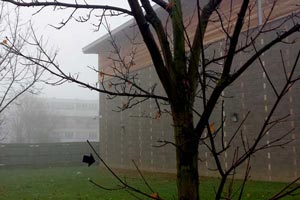NOTHING HAPPENED HERE




Part 1: Signified Sites of Interest
In this series of photographs from the period late-November 2012 – images from the Camberwell district of South London - CADE has marked certain details in the image with an arrow, but the reason for doing so is unclear. There are no close-ups to show us what is being signified. There are no captions to indicate the object of interest. Nothing can be seen in these pictures – at least, nothing out of the ordinary; the streets appear as they always do, day after day, albeit shrouded in a heavy fog.


Perhaps it was these missing close-ups, the missing object which is out-of-view, coarsely suggested by the black arrows hovering in the fog like flies above a corpse, that brought my mind back again and again to the image of some awful crime scene, some dreadful remnant of violence abandoned in an utterly ordinary place, absolutely lacking in drama or pathos; just another corpse discarded in some ungracious place; just more rubbish littering these already filthy streets and back yards.


But this is only what was suggested to me by looking over these images in sequence – and the only details observable were those deposited somewhere outside the image frame by my own lurid imagination. Naturally I was disturbed by this rather unpleasant idea and quickly decided that a more thorough investigation would need to be conducted before exhibiting this sequence of photographs in the public archive.
Searching through all the files, scraps of paper, images and videos relevant to the date of execution, I was able to find only one piece of corresponding evidence in all of CADE’s notes that seemed to have anything to do with this group of studies. It is a page, dated 28th November, upon which a map, (if it can really be called a map,) indicating nothing but ‘vague terrain’, with arrows scratched onto it.

Item #203: (dirty) map from CADE's notebook
The extremely disinterested and careless map-making skills exercised by CADE in this instance I decided to treat as a clue as to the significance of the images inasmuch as it is almost as if he is making a map with no use value, or that he is mapping something entirely mutable such as the kind of vague suggestion of the qualities of these particular places at these particular times; a common motif in CADE’s research.
***
Part 2: Revisiting and Re-Photographing the Sites
I decided to visit each of the locations in CADE’s photographs so as to investigate these details further, a feat I was ultimately able to achieve not my means of the map, (which is altogether useless,) but by using the street names in the photographs as a guide.


#1: Elmington Road (South) SE5


#2: Brunswick Park Primary School (North-North West) SE5


#3: Elmington Road (West) SE5


#4: Harris Street (North) SE5


#5: Elmington Road (East) SE5


#6: Brunswich Park Primary (West) SE5
Upon visiting each of the locations I concluded that none of the spots was extraordinary; indeed, as I was standing in the spots where CADE marked the original photographs, and when I stood in the spot from which CADE photographed them, I felt very strongly that nothing was extraordinary. It was as though my journey here and my investigation into these spots, my anticipation of some macabre discovery, would never be enough to make these places anything other than completely ordinary.
I can’t help getting the feeling that nothing happened here. Perhaps the thing with the arrows is just a red-herring, a misdirection to entice people into believing that something happened which didn’t – rather much in the same way that this whole archive strongly suggests that a war is happening or something, some grand disaster, only one which is so subtle it is almost impossible to detect. Once again I am cheated out of my fantasy of violence and it makes me sick. But then again, nothing ever happens in spots like this, even if they feel very strongly to you like they are the sorts of spots where something is bound to happen; places you typically avoid on your way home at night, pushing you in wide perimeters via a wide-berth, the long route home, without ever really being sure what for.

